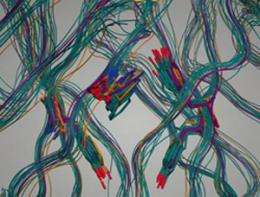Researchers engineer new way to inhibit allergic reactions without side effects

(Medical Xpress) -- Researchers from the University of Notre Dame have announced a breakthrough approach to allergy treatment that inhibits food allergies, drug allergies and asthmatic reactions without suppressing a sufferer’s entire immunological system.
The therapy centers on a special molecule the researchers designed, a heterobivalent ligand (HBL), which when introduced into a person’s bloodstream can, in essence, out-compete allergens like egg or peanut proteins in their race to attach to mast cells, a type of white blood cell that is the source of type-I hypersensitivity (that is, allergy).
“Unlike most current treatments, this approach prevents allergic reactions from occurring in the first place,” says Basar Bilgicer, assistant professor of chemical and biomolecular engineering and chemistry and biochemistry and principal investigator in Notre Dame’s Advanced Diagnostics & Therapeutics initiative.
Michael Handlogten, lead scientist on the paper and a graduate student in Bilgicer’s group, explained that among the various chemical functionalities he analyzed to be used as the scaffold HBL synthesis, ethylene glycol, an FDA-approved molecule, proved to be the most promising.
The research appears as the cover article in the Sept. 23, 2011, issue of the journal Chemistry & Biology.
Mast cells are part of the human body’s defense against parasites (such as tapeworms), and when working normally they are attracted to, attach to, and annihilate these pathogens. But type-I hypersensitivity occurs when the cells react to non-threatening substances. More common allergies are due to ambient stimulants, and an allergic response may range from a mild itch to life-threatening anaphylactic shock.
Tanyel Kiziltepe, a research professor in Advanced Diagnostics & Therapeutics, adds that “anaphylaxis can be caused by certain food allergens, insect stings, antibiotics and some medicines, and we believe HBL has a very high potential to be developed as a preventative medication."
While many medicines treat allergies by weakening a person’s entire immune system, this approach only disrupts the process whereby white blood cells bond with allergens in the first place.
“It also does not leave patients open to an increased risk for infections or the development of cancers,” explains Bilgicer. “HBLs may be most useful in situations where it’s not possible to speak to or gauge someone’s sensitivity.”
“For example, in an emergency, on a battlefield, or in a remote location, doctors may not be able to ask a patient about an allergy before administering penicillin. An engineered HBL could be given along with the medicine and perhaps prevent a deadly reaction from occurring.”
In a normal allergic reaction, allergens bind to a white blood cell, or “mast” cell, and cause the release of inflammatory molecules. Researchers at Notre Dame have shown how non-allergenic molecules, known as heterobivalent ligands, can be designed to attach to mast cells first, preventing the allergic reaction in the first place.















